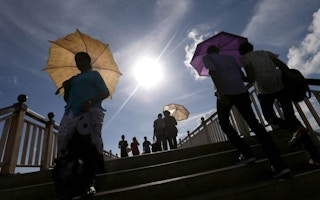Dinesh de Alwis has lived all his life in Ratmalana, a suburb of Sri Lanka’s capital Colombo. When he was young, he remembers, he would rush outside every day at 4 p.m., to play with friends after school.
“Now if you send the kids out at four, they would faint of heatstroke. It’s that bad,” said the 40-year-old father of two, of the searing heat that has become part of everyday life here.
Already steamy Colombo is expected to be one of the South Asian cities hardest hit by temperature hikes linked to climate change—hikes that are already being seen in many cities around the world.
As temperatures continue to rise, Sri Lanka’s Western Province—which includes Colombo—is likely to see a 7.5 per cent decline in living standards by 2050 “compared with a situation without changes in average weather”, according to a World Bank report released last month.
That is likely to have far-reaching national consequences as one of the nation’s key economic centres struggles to keep cool, the report said.
“This is a substantial drop, with potentially large implications for the country, given that the province contributes more than 40 per cent of Sri Lanka’s gross domestic product (GDP),” the report said.
“
Countries pay attention to disasters like floods and drought and make policy changes, but they should also look seriously at these kinds of slow-moving shifts that are happening, that could be equally dangerous.
Sunimal Jayathunga, director, national Climate Change Secretariat, Sri Lanka
Muthukumara Mani, a co-author of the report and the World Bank’s lead economist for South Asia, said that the impact will vary across different sections of the population, with outdoor workers or the poor unable to afford air conditioning, for instance, particularly hard hit, and energy costs rising for many.
“A rich household could be in a position to mitigate the impacts better than a poorer household, which would not have the financial capacity to do that,” Mani said. He said the construction industry and health systems are likely to feel the heat in particular.
Some families say they are already running up higher bills due to rising temperatures.
“When we were small we never used fans. It was never so warm that you could not sleep. Now we can’t sleep most nights without the air conditioner,” said De Alwis, who said he pays close to $70 each month for air conditioning.
Sunimal Jayathunga, director of the national Climate Change Secretariat noted that the country’s “adjustment to rising temperatures has not been ideal and (has been) too slow across the board”.
‘Urgent’ need to act
In the past decade, Colombo and the Western Province have been beset by worsening dengue outbreaks. Research by Sri Lanka’s University of Peradeniya has shown a link between rising temperatures, changing rainfall and outbreaks of the mosquito-carried disease.
According to the World Bank report, more than 800 million people in South Asia will be affected by rising temperatures by 2050 and Sri Lanka, in particular, will see a loss of at least $12 billion a year by 2050 if adequate measures are not taken to deal with temperature rise.
Temperatures in the region are expected to rise by up to 3 degrees by 2050, the report said.
Jayathunga, of the climate secretariat, said his agency was putting together plans for each of the country’s nine provinces to tackle climate change impacts. The plans are expected to be ready by the mid-2020s, he said.
He said Colombo needs to deal with a range of problems, from worsening flash flooding to a lack of clean water. “But tackling rising temperatures is one of the urgent ones,” he said.
Dealing with rising temperatures will require making Colombo’s people more aware of measures to adapt, such as conserving water and constructing buildings with more ventilation, Jayathunga said.
“But all this takes time,” he said.
The World Bank’s Mani said governments in South Asia have been focused on natural disasters and finding ways to deal with them, which has left more gradual and less visual threats, such as temperature hikes, overlooked in some places.
“Lots of the time countries pay attention to disasters like floods and drought and make policy changes, but they should also look seriously at these kinds of slow-moving shifts that are happening, that could be equally dangerous,” he said.
This story was published with permission from Thomson Reuters Foundation, the charitable arm of Thomson Reuters, that covers humanitarian news, climate change, resilience, women’s rights, trafficking and property rights. Visit http://news.trust.org/climate










